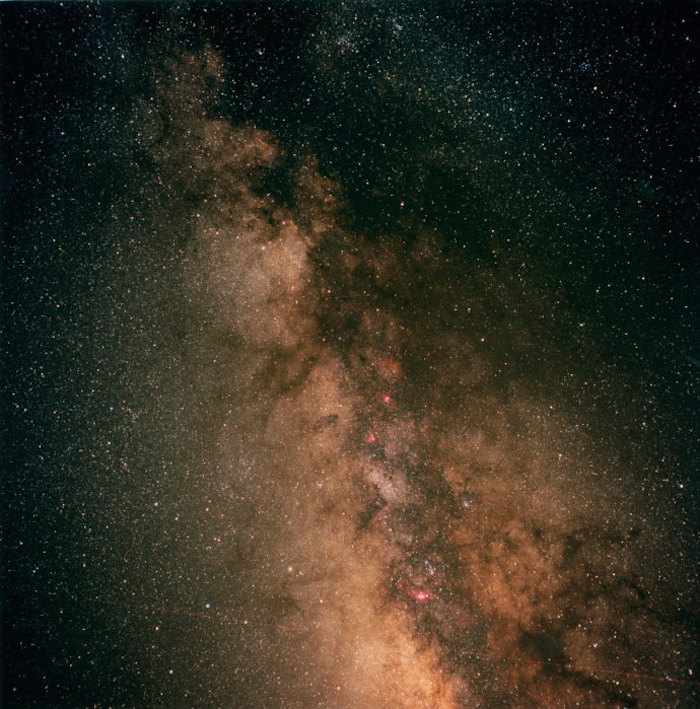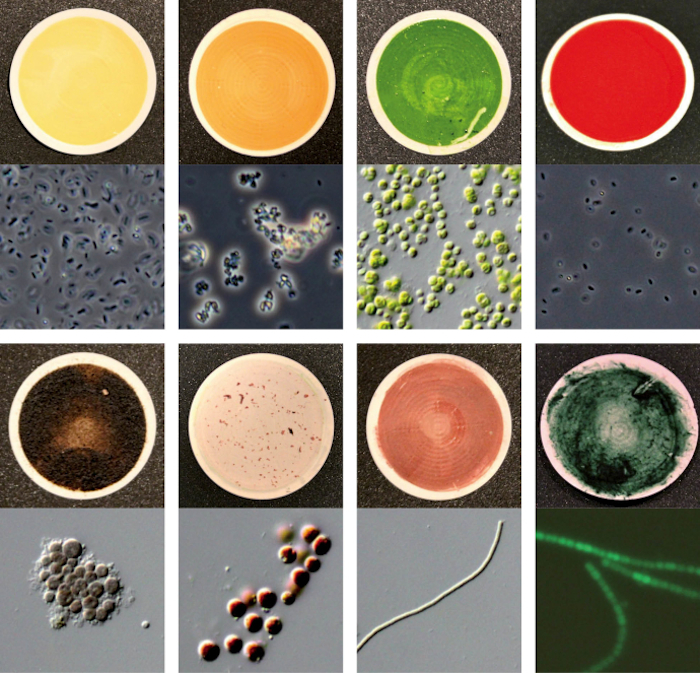.

The Milky Way, from Scutum to Serpens and northern Sagittarius.
-
Just before it became the first man-made vessel to leave the solar system, in 1990, Voyager 1 took a portrait of Earth, some four billion miles away. Our pinprick of a planet occupied a mere twelve per cent of one pixel, but its atmosphere, rich in water, oxygen, and ozone, reflected and scattered the glow of the sun in an unmistakable way; the astronomer Carl Sagan dubbed Earth the “pale blue dot.” Now, a quarter of a century later, a new generation of telescopes promises to let astronomers capture similarly small portraits of Earth-sized planets beyond our solar system—dots that may well be electric green or neon pink. And, just as Voyager’s image of Earth provided a pale-blue clue to our planet’s atmospheric chemistry, the colors of alien worlds will contain valuable information about their ability to support life. As Lynn Rothschild, an evolutionary biologist at NASA’s Ames Research Center, put it, “You have to milk that one lousy pixel for everything it has got.”
Last month, in the Proceedings of the National Academy of Sciences, Rothschild and her colleagues Siddharth Hegde, Lisa Kaltenegger, Ryan Kent, and Ivan G. Paulino-Limab announced the creation of an open-access database that aims to help astronomers do just that. It is a library of so-called biosignatures, the colors that living creatures—in this case, a hundred and thirty-seven species of microbe—reflect back when illuminated. The spectra range from the egg-yolk yellow of Halorubrum chaoviator, a single-celled organism that was isolated from Pacific sea salt, to the deep blue-green of Dermocarpa violacea, a cyanobacterium that was collected from an aquarium outflow in La Jolla, California. Viewed side by side in their petri dishes, the library’s sample colonies look like a set of punk eye shadows. “Among microbes, I think we’ve done a pretty darn good job of getting a snapshot of what colors exist on Earth,” Rothschild said.
.

A selection of eight microbial colonies from the biosignatures database.
.
Until recently, astronomers had focussed on analyzing a planet’s reflected light for evidence that its atmosphere contained oxygen or other gases that are considered to be positive indicators for the presence of life. In 2002, however, they proved for the first time that a pigment—chlorophyll, the molecule that makes plants and certain algae appear green to our eyes—could serve as a biosignature. By observing Earthshine, the sunlight that is reflected from Earth onto the surface of the moon, they were able to detect a “vegetation red edge,” a distinctive spike in the near-infrared region that is caused by chlorophyll. (To an alien equipped with infrared goggles, the faint glowing pixel that is Earth would actually have a hot-pink tinge.) But the chances of finding a chlorophyll-rich Earth analogue are slim. Indeed, if you had been an alien gazing at our planet relatively recently—four hundred and sixty million years ago, which is the equivalent of last Saturday on the cosmic calendar—land plants would not yet have been widespread, which would have meant no signature red edge. “Earth is the only example of life we have, and so we have to start from it,” Rothschild said. “But we have to be clever about it.” In other words, we have to go beyond chlorophyll to assemble a more expansive catalogue of life’s possible colors.
For Rothschild’s co-author Lisa Kaltenegger, the director of Cornell University’s newly formed Institute for Pale Blue Dots, this realization came during a NASA conference at Yellowstone National Park, where she noticed that colonies of geyser-dwelling microbes come in a rainbow of reds, oranges, yellows, greens, and browns. Rothschild has spent much of her career collecting and studying these sorts of extremophiles—organisms whose preferred habitats are too salty, too hot, too cold, too dry, or too dark for the rest of us. Although they are not the most visible form of life on Earth today, it is not hard to imagine them dominating other, hotter, colder, drier, darker, or saltier worlds. According to Rothschild and Kaltenegger, as we examine reflected light from around the galaxy, we’re at least as likely to spot an extremophile’s biosignature as an oak tree’s.
The database has its limitations. For starters, a planet orbiting a hot blue-white star will not have the same reflectance characteristics as a planet orbiting a cooler red dwarf. Moreover, certain surface features—mineral deposits, gases, ices—can distort the light, obscuring biosignatures or producing false positives. In the nineteen-fifties, the Harvard astronomer William Sinton made reflectance measurements of Mars that appeared to indicate the presence of lichen-type organisms. A decade later, the pattern that he observed was revealed to have been caused by molecules of heavy water in Earth’s own atmosphere. As Kaltenegger noted, matching the colors of life can only ever serve as a guide to, rather than a confirmation of, life’s presence. “We can say, ‘This planet looks pinkish,’ and then we can say, ‘Well, on Earth that would be this kind of algae,’ ” she said. “What we can’t say is that there is no other explanation for pinkishness.”
Being able to consult a library of biosignatures, however, will undoubtedly prove helpful. At the time that NASA launched Kepler, its planet-hunting spacecraft, in early 2009, astronomers had identified only about three hundred planets beyond our solar system. Most were gas giants, like Jupiter, and none looked particularly hospitable to life. But Kepler has identified more than a thousand smaller, more Earth-like planets within its narrow band of observation. Last month, researchers at Denmark’s Niels Bohr Institute, extrapolating from Kepler’s findings, suggested that there may be many billions of watery and rocky (and therefore potentially life-supporting) planets in the Milky Way alone. Though we won’t be paying these alien Earths a visit anytime soon, we can begin the process of sorting through them and selecting the best candidates now.
The developers of the database see ways of expanding its usefulness. Kaltenegger is at work on a paper discussing how much of a planet’s surface an organism has to cover in order to be detectable. Rothschild has been collaborating with a team of undergraduates from Stanford and Brown to engineer an artificial extremophile called Hell Cell; the project, or one like it, may free future astronomers from their terracentricity by giving them access to the biosignatures of speculative, synthetic life-forms. In the meantime, Rothschild expects her colleagues at NASA to find applications for the database here on Earth. The agency already uses satellite measurements of chlorophyll to detect whether crops are healthy or stressed; this new spectral catalogue could help track ebbs and flows in Earth’s microbiome, too. In contemplating the color of alien pixels, Rothschild, Kaltenegger, and their colleagues have opened the door to a better understanding of the only life that we know—in all of its multicolored, high-resolution splendor.
Quelle: The New Yorker
4881 Views
